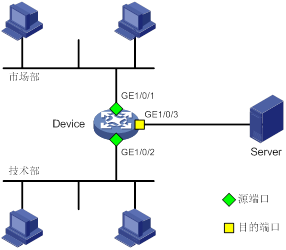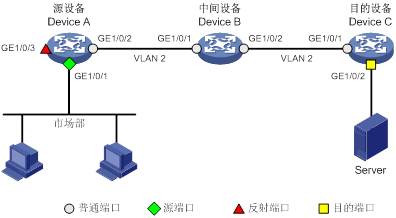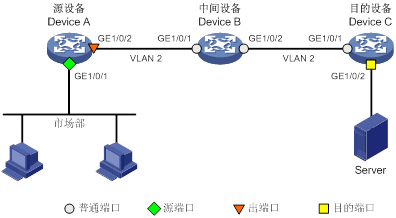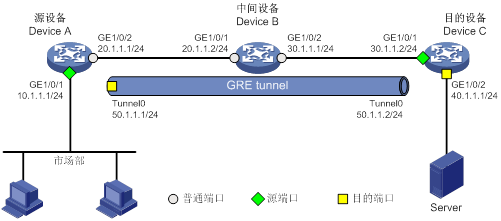s10506端口镜像配置问题
- 1关注
- 1收藏,1957浏览
问题描述:
求一份s10506交换机端口镜像的配置,谢谢
组网及组网描述:
求一份s10506交换机端口镜像的配置,谢谢
- 2020-05-07提问
- 举报
-
(0)
最佳答案

详细见如下网址。
https://www.h3c.com/cn/d_202001/1270152_30005_0.htm#_Toc29907789
1. 组网需求
· Device通过端口GigabitEthernet1/0/1和GigabitEthernet1/0/2分别连接市场部和技术部,并通过端口GigabitEthernet1/0/3连接Server。
· 通过配置源端口方式的本地端口镜像,使Server可以监控所有进、出市场部和技术部的报文。
2. 组网图
3. 配置步骤
# 创建本地镜像组1。
[Device] mirroring-group 1 local
# 配置本地镜像组1的源端口为GigabitEthernet1/0/1和GigabitEthernet1/0/2,目的端口为GigabitEthernet1/0/3。
[Device] mirroring-group 1 mirroring-port gigabitethernet 1/0/1 gigabitethernet 1/0/2 both
[Device] mirroring-group 1 monitor-port gigabitethernet 1/0/3
# 在目的端口GigabitEthernet1/0/3上关闭生成树协议。
[Device] interface gigabitethernet 1/0/3
[Device-GigabitEthernet1/0/3] undo stp enable
[Device-GigabitEthernet1/0/3] quit
4. 验证配置
# 显示所有镜像组的配置信息。
[Device] display mirroring-group all
Mirroring group 1:
Type: Local
Status: Active
Mirroring port:
GigabitEthernet1/0/1 Both
GigabitEthernet1/0/2 Both
Monitor port: GigabitEthernet1/0/3
配置完成后,用户可以通过Server监控所有进、出市场部和技术部的报文。
- 2020-05-07回答
- 评论(0)
- 举报
-
(0)

端口镜像典型配置举例
1.6.1 本地端口镜像配置举例(源端口方式)
1. 组网需求
· Device通过端口GigabitEthernet1/0/1和GigabitEthernet1/0/2分别连接市场部和技术部,并通过端口GigabitEthernet1/0/3连接Server。
· 通过配置源端口方式的本地端口镜像,使Server可以监控所有进、出市场部和技术部的报文。
2. 组网图
3. 配置步骤
# 创建本地镜像组1。
[Device] mirroring-group 1 local
# 配置本地镜像组1的源端口为GigabitEthernet1/0/1和GigabitEthernet1/0/2,目的端口为GigabitEthernet1/0/3。
[Device] mirroring-group 1 mirroring-port gigabitethernet 1/0/1 gigabitethernet 1/0/2 both
[Device] mirroring-group 1 monitor-port gigabitethernet 1/0/3
# 在目的端口GigabitEthernet1/0/3上关闭生成树协议。
[Device] interface gigabitethernet 1/0/3
[Device-GigabitEthernet1/0/3] undo stp enable
[Device-GigabitEthernet1/0/3] quit
4. 验证配置
# 显示所有镜像组的配置信息。
[Device] display mirroring-group all
Mirroring group 1:
Type: Local
Status: Active
Mirroring port:
GigabitEthernet1/0/1 Both
GigabitEthernet1/0/2 Both
Monitor port: GigabitEthernet1/0/3
配置完成后,用户可以通过Server监控所有进、出市场部和技术部的报文。
1.6.2 本地端口镜像配置举例(源CPU方式)
1. 组网需求
· Device通过位于其1号槽位单板上的端口GigabitEthernet1/0/1和GigabitEthernet1/0/2分别连接市场部和技术部,并通过端口GigabitEthernet1/0/3连接Server。
· 通过配置源CPU方式的本地端口镜像,使Server可以监控所有进、出市场部和技术部的,且需要经Device A的1号槽位单板上CPU处理的报文。
2. 组网图
3. 配置步骤
# 创建本地镜像组1。
[Device] mirroring-group 1 local
# 配置本地镜像组1的源CPU为位于1号槽位单板上的CPU,目的端口为GigabitEthernet1/0/3。
[Device] mirroring-group 1 mirroring-cpu slot 1 both
[Device] mirroring-group 1 monitor-port gigabitethernet 1/0/3
# 在目的端口GigabitEthernet1/0/3上关闭生成树协议。
[Device] interface gigabitethernet 1/0/3
[Device-GigabitEthernet1/0/3] undo stp enable
[Device-GigabitEthernet1/0/3] quit
4. 验证配置
# 显示所有镜像组的配置信息。
[Device] display mirroring-group all
Mirroring group 1:
Type: Local
Status: Active
Mirroring CPU:
Slot 1 Both
Monitor port: GigabitEthernet1/0/3
配置完成后,用户可以通过Server监控所有进、出市场部和技术部的,且需要经Device A的1号槽位单板上CPU处理的报文。
1.6.3 二层远程端口镜像配置举例(非固定反射端口方式)
1. 组网需求
· 在一个二层网络中,Device A、Device B、Device C及Server如下图所示连接。其中,Device A通过端口GigabitEthernet1/0/1连接市场部。
· 通过配置二层远程端口镜像,使Server可以监控所有进、出市场部的报文。
2. 组网图
3. 配置步骤
# 配置端口GigabitEthernet1/0/1为Trunk口,并允许VLAN 2的报文通过。
[DeviceC] interface gigabitethernet 1/0/1
[DeviceC-GigabitEthernet1/0/1] port link-type trunk
[DeviceC-GigabitEthernet1/0/1] port trunk permit vlan 2
[DeviceC-GigabitEthernet1/0/1] quit
# 创建远程目的镜像组2。
[DeviceC] mirroring-group 2 remote-destination
# 创建VLAN 2作为远程镜像VLAN。
# 关闭VLAN 2的MAC地址学习功能。
[DeviceC-vlan2] undo mac-address mac-learning enable
[DeviceC-vlan2] quit
# 配置远程目的镜像组2的远程镜像VLAN为VLAN 2,目的端口为GigabitEthernet1/0/2,在该端口上关闭生成树协议并将其加入VLAN 2。
[DeviceC] mirroring-group 2 remote-probe vlan 2
[DeviceC] interface gigabitethernet 1/0/2
[DeviceC-GigabitEthernet1/0/2] mirroring-group 2 monitor-port
[DeviceC-GigabitEthernet1/0/2] undo stp enable
[DeviceC-GigabitEthernet1/0/2] port access vlan 2
[DeviceC-GigabitEthernet1/0/2] quit
# 创建VLAN 2作为远程镜像VLAN。
[DeviceB] vlan 2
# 关闭VLAN 2的MAC地址学习功能。
[DeviceB-vlan2] undo mac-address mac-learning enable
[DeviceB-vlan2] quit
# 配置端口GigabitEthernet1/0/1为Trunk口,并允许VLAN 2的报文通过。
[DeviceB] interface gigabitethernet 1/0/1
[DeviceB-GigabitEthernet1/0/1] port link-type trunk
[DeviceB-GigabitEthernet1/0/1] port trunk permit vlan 2
[DeviceB-GigabitEthernet1/0/1] quit
# 配置端口GigabitEthernet1/0/2为Trunk口,并允许VLAN 2的报文通过。
[DeviceB] interface gigabitethernet 1/0/2
[DeviceB-GigabitEthernet1/0/2] port link-type trunk
[DeviceB-GigabitEthernet1/0/2] port trunk permit vlan 2
[DeviceB-GigabitEthernet1/0/2] quit
# 创建远程源镜像组1。
[DeviceA] mirroring-group 1 remote-source
# 创建VLAN 2作为远程镜像VLAN。
# 关闭VLAN 2的MAC地址学习功能。
[DeviceA-vlan2] undo mac-address mac-learning enable
[DeviceA-vlan2] quit
# 配置远程源镜像组1的远程镜像VLAN为VLAN 2,源端口为GigabitEthernet1/0/1,反射端口为GigabitEthernet1/0/3。
[DeviceA] mirroring-group 1 remote-probe vlan 2
[DeviceA] mirroring-group 1 mirroring-port gigabitethernet 1/0/1 both
[DeviceA] mirroring-group 1 reflector-port gigabitethernet 1/0/3
This operation may delete all settings made on the interface. Continue? [Y/N]: y
# 配置端口GigabitEthernet1/0/2为Trunk口,并允许VLAN 2的报文通过。
[DeviceA] interface gigabitethernet 1/0/2
[DeviceA-GigabitEthernet1/0/2] port link-type trunk
[DeviceA-GigabitEthernet1/0/2] port trunk permit vlan 2
[DeviceA-GigabitEthernet1/0/2] quit
4. 验证配置
# 显示Device C上所有镜像组的配置信息。
[DeviceC] display mirroring-group all
Mirroring group 2:
Type: Remote destination
Status: Active
Monitor port: GigabitEthernet1/0/2
Remote probe VLAN: 2
# 显示Device A上所有镜像组的配置信息。
[DeviceA] display mirroring-group all
Mirroring group 1:
Type: Remote source
Status: Active
Mirroring port:
GigabitEthernet1/0/1 Both
Reflector port: GigabitEthernet1/0/3
Remote probe VLAN: 2
配置完成后,用户可以通过Server监控所有进、出市场部的报文。
1.6.4 二层远程端口镜像配置举例(出端口方式)
1. 组网需求
· 在一个二层网络中,Device A、Device B、Device C及Server如下图所示连接。其中,Device A通过端口GigabitEthernet1/0/1连接市场部。
· 通过配置二层远程端口镜像,使Server可以监控所有进、出市场部的报文。
2. 组网图
3. 配置步骤
# 配置端口GigabitEthernet1/0/1为Trunk口,并允许VLAN 2的报文通过。
[DeviceC] interface gigabitethernet 1/0/1
[DeviceC-GigabitEthernet1/0/1] port link-type trunk
[DeviceC-GigabitEthernet1/0/1] port trunk permit vlan 2
[DeviceC-GigabitEthernet1/0/1] quit
# 创建远程目的镜像组2。
[DeviceC] mirroring-group 2 remote-destination
# 创建VLAN 2作为远程镜像VLAN。
# 关闭VLAN 2的MAC地址学习功能。
[DeviceC-vlan2] undo mac-address mac-learning enable
[DeviceC-vlan2] quit
# 配置远程目的镜像组2的远程镜像VLAN为VLAN 2,目的端口为GigabitEthernet1/0/2,在该端口上关闭生成树协议并将其加入VLAN 2。
[DeviceC] mirroring-group 2 remote-probe vlan 2
[DeviceC] interface gigabitethernet 1/0/2
[DeviceC-GigabitEthernet1/0/2] mirroring-group 2 monitor-port
[DeviceC-GigabitEthernet1/0/2] undo stp enable
[DeviceC-GigabitEthernet1/0/2] port access vlan 2
[DeviceC-GigabitEthernet1/0/2] quit
# 创建VLAN 2作为远程镜像VLAN。
[DeviceB] vlan 2
# 关闭VLAN 2的MAC地址学习功能。
[DeviceB-vlan2] undo mac-address mac-learning enable
[DeviceB-vlan2] quit
# 配置端口GigabitEthernet1/0/1为Trunk口,并允许VLAN 2的报文通过。
[DeviceB] interface gigabitethernet 1/0/1
[DeviceB-GigabitEthernet1/0/1] port link-type trunk
[DeviceB-GigabitEthernet1/0/1] port trunk permit vlan 2
[DeviceB-GigabitEthernet1/0/1] quit
# 配置端口GigabitEthernet1/0/2为Trunk口,并允许VLAN 2的报文通过。
[DeviceB] interface gigabitethernet 1/0/2
[DeviceB-GigabitEthernet1/0/2] port link-type trunk
[DeviceB-GigabitEthernet1/0/2] port trunk permit vlan 2
[DeviceB-GigabitEthernet1/0/2] quit
# 创建远程源镜像组1。
[DeviceA] mirroring-group 1 remote-source
# 创建VLAN 2作为远程镜像VLAN。
# 关闭VLAN 2的MAC地址学习功能。
[DeviceA-vlan2] undo mac-address mac-learning enable
[DeviceA-vlan2] quit
# 配置远程源镜像组1的远程镜像VLAN为VLAN 2,源端口为GigabitEthernet1/0/1,出端口为GigabitEthernet1/0/2。
[DeviceA] mirroring-group 1 remote-probe vlan 2
[DeviceA] mirroring-group 1 mirroring-port gigabitethernet 1/0/1 both
[DeviceA] mirroring-group 1 monitor-egress gigabitethernet 1/0/2
# 配置端口GigabitEthernet1/0/2为Trunk口,允许VLAN 2的报文通过,并在该端口上关闭生成树协议。
[DeviceA] interface gigabitethernet 1/0/2
[DeviceA-GigabitEthernet1/0/2] port link-type trunk
[DeviceA-GigabitEthernet1/0/2] port trunk permit vlan 2
[DeviceA-GigabitEthernet1/0/2] undo stp enable
[DeviceA-GigabitEthernet1/0/2] quit
4. 验证配置
# 显示Device C上所有镜像组的配置信息。
[DeviceC] display mirroring-group all
Mirroring group 2:
Type: Remote destination
Status: Active
Monitor port: GigabitEthernet1/0/2
Remote probe VLAN: 2
# 显示Device A上所有镜像组的配置信息。
[DeviceA] display mirroring-group all
Mirroring group 1:
Type: Remote source
Status: Active
Mirroring port:
GigabitEthernet1/0/1 Both
Monitor egress port: Gigabitethernet1/0/2
Remote probe VLAN: 2
配置完成后,用户可以通过Server监控所有进、出市场部的报文。
1.6.5 三层远程端口镜像配置举例
1. 组网需求
· 在一个三层网络中,Device A、Device B、Device C及Server如下图所示连接。其中,Device A通过端口GigabitEthernet1/0/1连接市场部。
· 通过配置三层远程端口镜像,并建立OSPF方式的GRE隧道,使得Server可以通过由GRE隧道传输的镜像报文来监控所有进、出市场部的报文。
2. 组网图
3. 配置步骤
(1) 配置IP地址
请按照图1-9配置各接口的IP地址和子网掩码,具体配置过程略。
# 创建业务环回组1,并配置服务类型为Tunnel。
[DeviceA] service-loopback group 1 type tunnel
# 将接口GigabitEthernet1/0/3加入业务环回组1。
[DeviceA] interface gigabitethernet 1/0/3
[DeviceA-GigabitEthernet1/0/3] port service-loopback group 1
All configurations on the interface will be lost. Continue?[Y/N]:y
[DeviceA-GigabitEthernet1/0/3] quit
# 创建GRE模式的Tunnel接口1,并为其配置IP地址和掩码。
[DeviceA] interface tunnel 1 mode gre
[DeviceA-Tunnel1] ip address 50.1.1.1 24
# 为Tunnel接口1分别指定源地址和目的地址。
[DeviceA-Tunnel1] source 20.1.1.1
[DeviceA-Tunnel1] destination 30.1.1.2
[DeviceA-Tunnel1] quit
# 配置OSPF协议。
[DeviceA-ospf-1] area 0
[DeviceA-ospf-1-area-0.0.0.0] network 10.1.1.0 0.0.0.255
[DeviceA-ospf-1-area-0.0.0.0] network 20.1.1.0 0.0.0.255
[DeviceA-ospf-1-area-0.0.0.0] quit
[DeviceA-ospf-1] quit
# 创建本地镜像组1。
[DeviceA] mirroring-group 1 local
# 配置本地镜像组1的源端口为GigabitEthernet1/0/1,目的端口为Tunnel1。
[DeviceA] mirroring-group 1 mirroring-port gigabitethernet 1/0/1 both
[DeviceA] mirroring-group 1 monitor-port tunnel 1
# 配置OSPF协议。
[DeviceB] ospf 1
[DeviceB-ospf-1] area 0
[DeviceB-ospf-1-area-0.0.0.0] network 20.1.1.0 0.0.0.255
[DeviceB-ospf-1-area-0.0.0.0] network 30.1.1.0 0.0.0.255
[DeviceB-ospf-1-area-0.0.0.0] quit
[DeviceB-ospf-1] quit
# 创建业务环回组1,并配置服务类型为Tunnel。
[DeviceC] service-loopback group 1 type tunnel
# 将接口GigabitEthernet1/0/3加入业务环回组1。
[DeviceC] interface gigabitethernet 1/0/3
[DeviceC-GigabitEthernet1/0/3] port service-loopback group 1
All configurations on the interface will be lost. Continue?[Y/N]:y
[DeviceC-GigabitEthernet1/0/3] quit
# 创建GRE模式的Tunnel接口1,并为其配置IP地址和掩码。
[DeviceC] interface tunnel 1 mode gre
[DeviceC-Tunnel1] ip address 50.1.1.2 24
# 为Tunnel接口1分别指定源地址和目的地址。
[DeviceC-Tunnel1] source 30.1.1.2
[DeviceC-Tunnel1] destination 20.1.1.1
[DeviceC-Tunnel1] quit
# 配置OSPF协议。
[DeviceC-ospf-1] area 0
[DeviceC-ospf-1-area-0.0.0.0] network 30.1.1.0 0.0.0.255
[DeviceC-ospf-1-area-0.0.0.0] network 40.1.1.0 0.0.0.255
[DeviceC-ospf-1-area-0.0.0.0] quit
[DeviceC-ospf-1] quit
# 创建本地镜像组1。
[DeviceC] mirroring-group 1 local
# 配置本地镜像组1的源端口为GigabitEthernet1/0/1,目的端口为GigabitEthernet1/0/2。
[DeviceC] mirroring-group 1 mirroring-port gigabitethernet 1/0/1 inbound
[DeviceC] mirroring-group 1 monitor-port gigabitethernet 1/0/2
4. 验证配置
# 显示Device A上所有镜像组的配置信息。
[DeviceA] display mirroring-group all
Mirroring group 1:
Type: Local
Status: Active
Mirroring port:
GigabitEthernet1/0/1 Both
Monitor port: Tunnel1
# 显示Device C上所有镜像组的配置信息。
[DeviceC] display mirroring-group all
Mirroring group 1:
Type: Local
Status: Active
Mirroring port:
GigabitEthernet1/0/1 Inbound
Monitor port: GigabitEthernet1/0/2
配置完成后,用户可以通过Server监控所有进、出市场部的报文。
2 流镜像
2.1 流镜像简介
流镜像是指将指定报文复制到指定目的地,以便于对报文进行分析和监控。流镜像通过QoS策略来实现,即使用流分类技术为待镜像报文定义匹配条件,再通过配置流行为将符合条件的报文镜像至指定目的地。其优势在于用户通过流分类技术可以灵活地配置匹配条件,从而对报文进行精细区分,并将区分后的报文复制到目的地进行分析。有关QoS策略、流分类和流行为的详细介绍,请参见“ACL和QoS配置指导”中的“QoS配置方式”。
· 流镜像到接口:将符合条件的报文复制一份到指定接口(与数据检测设备相连的接口),利用数据检测设备分析接口收到的报文。
· 流镜像到CPU:将符合条件的报文复制一份到CPU(这里的CPU是指报文进入的单板上的CPU),通过CPU分析报文的内容,或者将特定的协议报文上送。
2.2 流镜像配置任务简介
配置QoS策略 | |||
应用QoS策略 | 指定对来自哪个端口、VLAN等的流量进行镜像 | ||
基于VLAN应用 | |||
2.3 配置流镜像
除mirror-to命令外的其他配置命令及相关显示命令的详细介绍,请参见“ACL和QoS命令参考”中的“QoS策略”。
2.3.1 配置报文匹配规则
2.3.2 配置流行为
· 在完成上述配置后,在任意视图下执行display traffic behavior命令可以显示用户定义流行为的配置信息,通过查看显示信息验证配置的效果。
· 上述CPU是指配置了流镜像的单板上的CPU。
2.3.3 配置QoS策略
定义QoS策略,并进入QoS策略视图 | ||
在完成上述配置后,在任意视图下执行display qos policy命令可以显示用户定义策略的配置信息,通过查看显示信息验证配置的效果。
2.3.4 应用QoS策略
1. 基于接口应用
将QoS策略应用到某接口,可以对该接口指定方向上的流量进行镜像。一个QoS策略可以应用于多个接口,而接口在每个方向上只能应用一个QoS策略。
应用QoS策略到接口 |
2. 基于VLAN应用
将QoS策略应用到某VLAN,可以对该VLAN内各端口指定方向上的流量进行镜像。
3. 基于全局应用
将QoS策略应用到全局,可以对设备各端口指定方向上的流量进行镜像。
4. 基于控制平面应用
将QoS策略应用到控制平面,可以对控制平面各端口指定方向上的流量进行镜像。
- | ||
进入控制平面视图(IRF模式) | - | |
应用QoS策略到控制平面 |
2.4 流镜像典型配置举例
1. 组网需求
· 某公司内的各部门之间使用不同网段的IP地址,其中市场部和技术部分别使用192.168.1.0/24和192.168.2.0/24网段,该公司的工作时间为每周工作日的8点到18点。
· 通过配置流镜像,使Server可以监控技术部访问互联网的WWW流量,以及技术部在工作时间发往市场部的IP流量。
2. 组网图
3. 配置步骤
# 定义工作时间:创建名为work的时间段,其时间范围为每周工作日的8点到18点。
[Device] time-range work 8:00 to 18:00 working-day
# 创建ACL 3000,并定义如下规则:匹配技术部访问WWW的报文,以及在工作时间由技术部发往市场部的IP报文。
[Device-acl-ipv4-adv-3000] rule permit tcp source 192.168.2.0 0.0.0.255 destination-port eq www
[Device-acl-ipv4-adv-3000] rule permit ip source 192.168.2.0 0.0.0.255 destination 192.168.1.0 0.0.0.255 time-range work
[Device-acl-ipv4-adv-3000] quit
# 创建流分类tech_c,并配置报文匹配规则为ACL 3000。
[Device] traffic classifier tech_c
[Device-classifier-tech_c] if-match acl 3000
[Device-classifier-tech_c] quit
# 创建流行为tech_b,并配置流镜像到接口GigabitEthernet1/0/3。
[Device] traffic behavior tech_b
[Device-behavior-tech_b] mirror-to interface gigabitethernet 1/0/3
[Device-behavior-tech_b] quit
# 创建QoS策略tech_p,在策略中为流分类tech_c指定采用流行为tech_b。
[Device-qospolicy-tech_p] classifier tech_c behavior tech_b
[Device-qospolicy-tech_p] quit
# 将QoS策略tech_p应用到接口GigabitEthernet1/0/4的入方向上。
[Device] interface gigabitethernet 1/0/4
[Device-GigabitEthernet1/0/4] qos apply policy tech_p inbound
[Device-GigabitEthernet1/0/4] quit
4. 验证配置
配置完成后,用户可以通过Server监控技术部访问互联网的WWW流量,以及技术部在工作时间发往市场部的IP流量。
- 2020-05-07回答
- 评论(2)
- 举报
-
(0)
可以啊
s10506配置远程镜像之后,本地镜像就不能创建了是吧?
可以啊
编辑答案


亲~登录后才可以操作哦!
确定你的邮箱还未认证,请认证邮箱或绑定手机后进行当前操作
举报
×
侵犯我的权益
×
侵犯了我企业的权益
×
- 1. 您举报的内容是什么?(请在邮件中列出您举报的内容和链接地址)
- 2. 您是谁?(身份证明材料,可以是身份证或护照等证件)
- 3. 是哪家企业?(营业执照,单位登记证明等证件)
- 4. 您与该企业的关系是?(您是企业法人或被授权人,需提供企业委托授权书)
抄袭了我的内容
×
原文链接或出处
诽谤我
×
- 1. 您举报的内容以及侵犯了您什么权益?(请在邮件中列出您举报的内容、链接地址,并给出简短的说明)
- 2. 您是谁?(身份证明材料,可以是身份证或护照等证件)
对根叔社区有害的内容
×
不规范转载
×
举报说明







